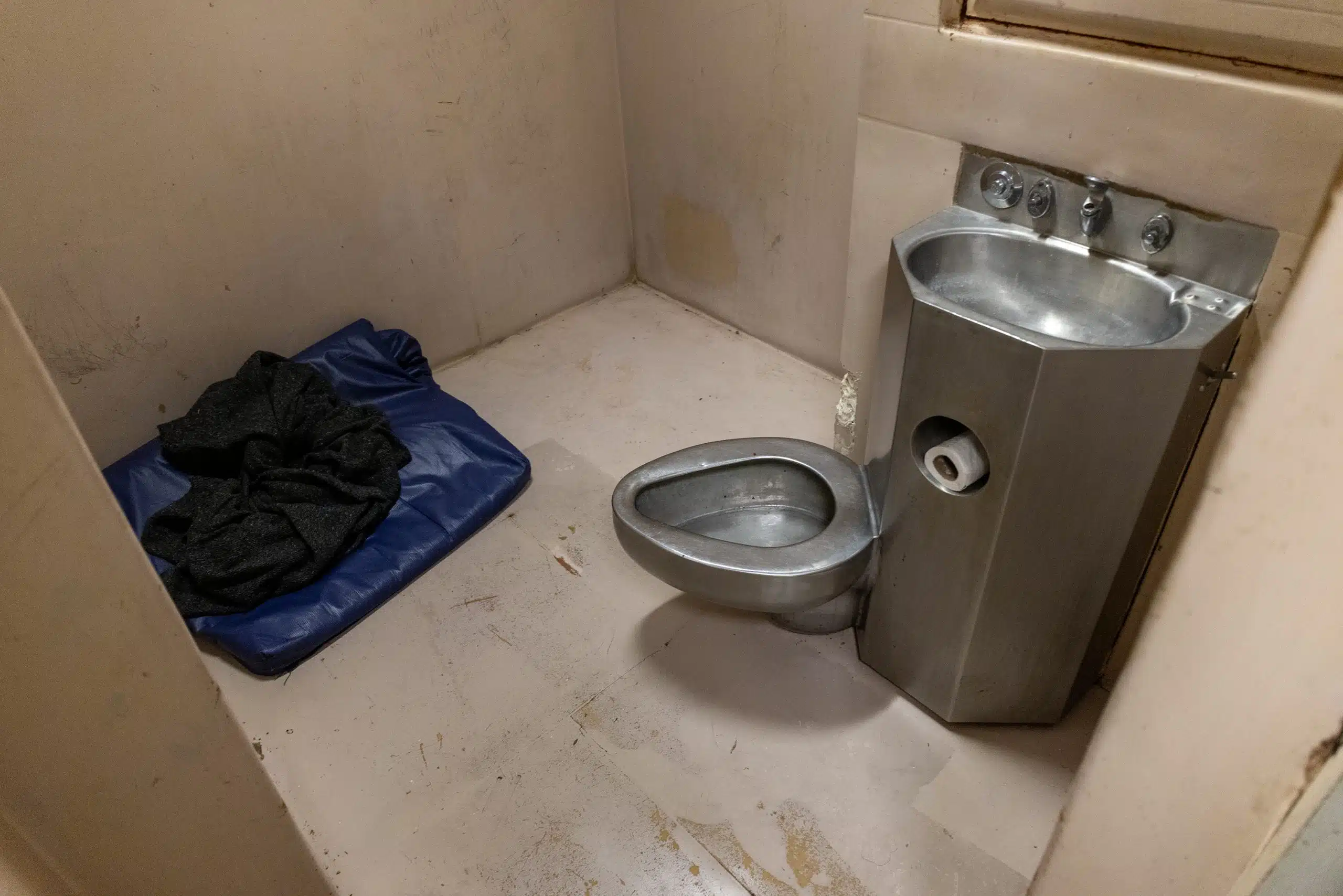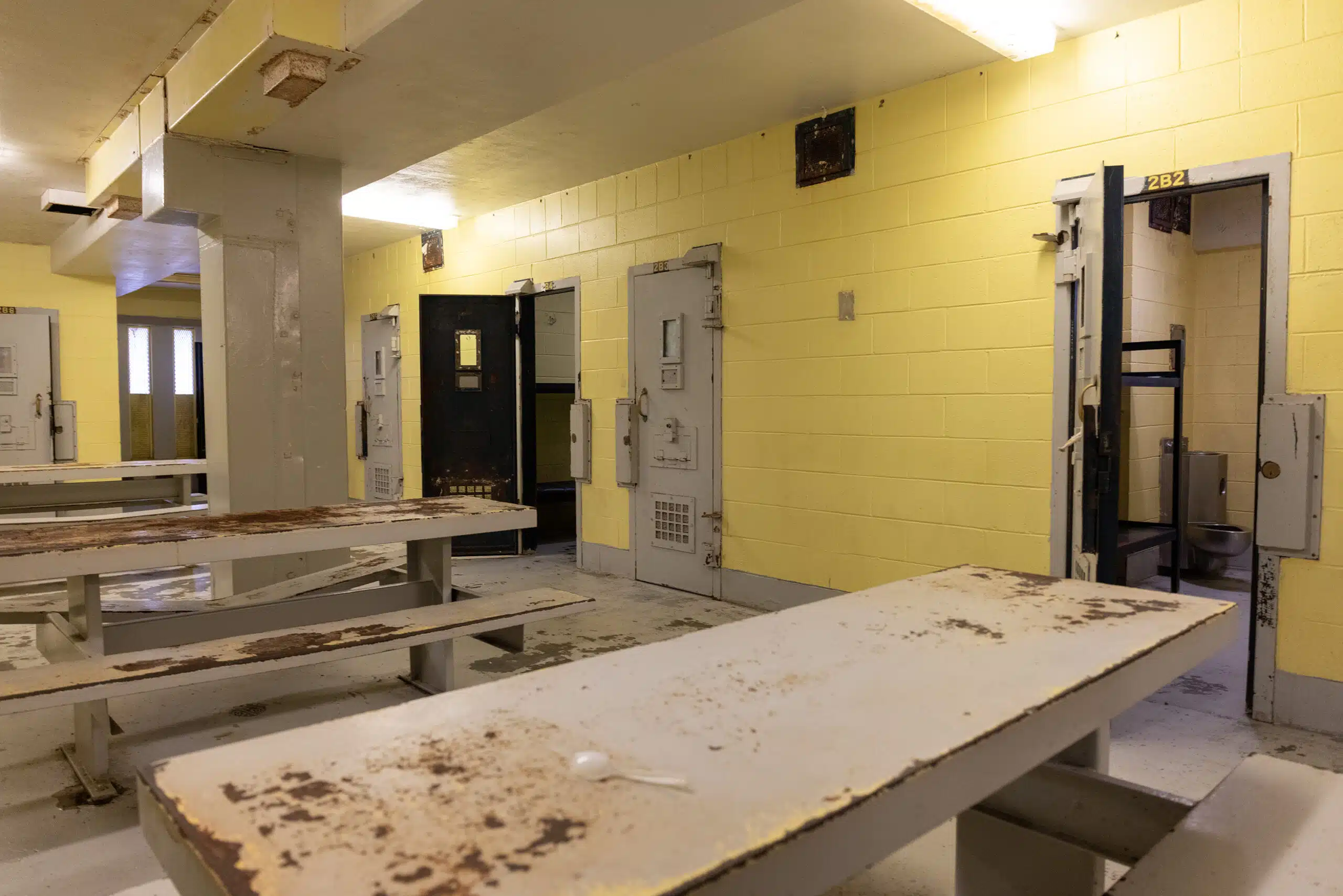Mississippi Today
Mississippi jailed more than 800 people awaiting psychiatric treatment in a year. Just one jail meets state standards.

This article was produced for ProPublica’s Local Reporting Network in partnership with Mississippi Today. Sign up for Dispatches to get stories like this one as soon as they are published.
In Mississippi, many people awaiting court-ordered treatment for mental illness or substance abuse are jailed, even though they haven’t been charged with a crime. Read our full series here.
Fourteen years ago, Mississippi legislators passed a law requiring county jails to be certified by the state if they held people awaiting court-ordered psychiatric treatment.
Today, just one jail in the state is certified.
And yet, from July 2022 to June 2023, more than 800 people awaiting treatment were jailed throughout the state, almost all in uncertified facilities, according to state data.
Mississippi Today and ProPublica have been reporting on county officials’ practice of jailing people with mental illness, most of whom haven’t been charged with a crime, as they await treatment under the state’s civil commitment law. After the news organizations started asking about the 2009 law earlier this year, the state attorney general’s office concluded that it is a “mandatory requirement” that the Mississippi Department of Mental Health certify the facilities where people are held after judges have ordered them into treatment.
The Department of Mental Health, which oversees the state’s behavioral health system and has no other responsibility for jails, responded by sending letters to county officials across the state encouraging them to stop holding people in uncertified jails. But the law provides no funding to help counties comply and no penalties if they don’t.

Under state law, counties are responsible for housing people going through the commitment process until they are admitted to a state hospital. Counties are allowed to put them in jail before their court hearings if there’s “no reasonable alternative.”
The last time the Department of Mental Health tried to ensure those jails met state standards, more than a decade ago, it had little success. After the law passed, the agency got to work to inform counties about the new rules. Some didn’t respond. Others expressed interest but didn’t follow through. By 2013, just two jails had been certified. (One of them no longer is.) After that, the effort apparently petered out, according to a review of state documents.
To be certified, a jail must offer on-call crisis care by a physician or psychiatric nurse practitioner and must have a supply of medications. Staff must be trained in crisis intervention and suicide prevention. People detained during the commitment process must be housed separately from people charged with crimes, in rooms free of fixtures or structures that could be used for self-harm, according to Department of Mental Health standards that took effect in 2011.
“If they’re going to be held in jail, they have to receive some kind of treatment in a semi-safe environment,” a department attorney told The Clarion-Ledger at the time.
Until recently, many county officials weren’t even aware of those requirements, according to interviews across the state — even though they were routinely jailing people solely because they might need mental health treatment. Mississippi appears to be the only state in the country where people awaiting treatment are commonly jailed without charges for days or weeks at a time.
Mississippi jails are subject to no statewide health and safety standards. Many jails treat people going through the civil commitment process virtually the same as those who have been charged with crimes, Mississippi Today and ProPublica found. They’re shackled and given jail uniforms. They’re often held in the same cells as criminal defendants. They receive minimal medical care. Some said they couldn’t access prescribed psychiatric medications. Since 1987, at least 18 people going through the commitment process for mental illness and substance abuse have died after being jailed, most of them by suicide.

Some local officials say getting certified could be expensive. Sheriffs worry it could codify their role as their county’s de facto mental health care provider.
“It looks like the state wants the sheriff to be the chief mental health officer,” said Will Allen, attorney for the Mississippi Sheriffs’ Association. “This is coming down to the state stuffing the cost of this down to the counties, and frankly I just think that’s wrong.”
‘Are you going to shut the jail down? No.’
The genesis of the 2009 law was a conversation state Sen. Joey Fillingane had with his girlfriend at the time, a social worker who worked with troubled youth. She told him that Mississippians going through the commitment process in some counties were locked in jail cells like criminals, while in other counties they were held in hospitals like patients, according to a 2011 news story in The Clarion-Ledger.
Fillingane’s bill addressed that. “Shouldn’t there be some kind of minimum standard where you’re holding people who haven’t committed a crime?” the Republican from Sumrall, near Hattiesburg, said in that story about his legislation.
His bill passed with little fanfare. It made it “illegal for individuals committed to a DMH behavioral health program to be held in jail unless it had been certified” as a holding facility, an agency staffer wrote in a timeline of the law’s implementation obtained by Mississippi Today and ProPublica.
The board overseeing the Department of Mental Health set detailed standards for those facilities. Department staff surveyed counties to see whether they could meet them.
Ed LeGrand was head of the department when the law passed. He said he viewed it as a progressive effort that could spur counties to stop holding mentally ill people in jail. And even if that didn’t happen, the law would improve jail conditions — at least somewhat.
“I didn’t think that everybody would be able to meet those standards. I thought they would give it a try,” he said in a recent interview. “A lot of them did, but some of them didn’t.”
Department staff met with county officials and toured jails to offer assistance. Those visits, which records show mostly took place in 2011 and 2012, were the first time the Department of Mental Health had tried to get a comprehensive look at the local facilities where Mississippians awaited psychiatric treatment in state hospitals, LeGrand said.
Many jails were poorly equipped to care for these people, according to notes by agency staff.
“Toured the current jail (scary),” reads a status update written after staff visited Tishomingo County, in the northeast corner of the state, shortly before the county opened a new jail. In Jones County in south Mississippi, where the jail had 180 inmates and only four staff: “The holding cells are not safe for violent behavior. Too much cement.”
Jones County Sheriff Joe Berlin said the cells have not changed since then, though now detainees are monitored with cameras.
In early 2011, LeGrand told county officials who hadn’t already begun the certification process that they had six months to find a certified provider to house people awaiting treatment.
Sheriffs were frustrated. Some objected to being told they had to upgrade their jails and train guards so they could care for mentally ill people they didn’t think they should be responsible for in the first place.
“What do they expect of me?” one sheriff was quoted as saying in the 2011 news story. “What they need to do is turn around and certify some places that are under Mental Health’s control so they can be responsible for it, not me.”

Some county officials concluded there was little the state could do if they didn’t comply. Mike Harlin, the jail administrator in Lamar County, discussed the standards with a Department of Mental Health staffer in 2012, according to an agency memo. In an interview this year, Harlin said he remembered thinking, “What are you going to do? Are you going to shut the jail down? No.”
By June 2013, jails in just two of the state’s 82 counties had been certified, according to the department’s tally. (A hospital was certified in another county, and a different type of facility was certified in a fourth.)
Six counties said they couldn’t meet the standards. Another 23 had received guidance from the department on how to meet them. Thirty, including a few of the counties that had received advice, eventually said they didn’t jail people, some because they had contracts with providers. Twenty-one never responded.
Mississippi Today and ProPublica requested all Department of Mental Health records since 2010 related to enforcement of the certification law and correspondence with counties. Documents through 2013 included standards, correspondence, memos describing visits to county facilities and a log summarizing contact with each county. After that, the records released show no statewide outreach.
The final entry in the department’s timeline of the law’s implementation reads: “June 2013 was the last attempt to update the information about DMH Designated Mental Health Holding Facilities due to lack of additional responses from the counties.” That timeline is undated, but a department spokesperson said data in the file shows that it was created in January 2015 by a staffer who held positions in the certification and behavioral health divisions.
LeGrand, who served until 2014, said he doesn’t recall any decision to stop contacting counties about the law.
Katie Storr, the current chief of staff at the Department of Mental Health, told Mississippi Today and ProPublica it’s possible staff did communicate with counties beyond what the records indicate. “After more than a decade, a lack of correspondence, email, or other documentation is not indicative that communication and follow-ups did not take place,” she wrote in an email. However, she said the department had no additional records that would show this.
During this time, Storr wrote, the department was focused on trying to get counties to hold people going through the commitment process in short-term crisis stabilization units rather than jail.
Department can’t ‘boss counties around’
The recent effort to implement the certification law stems from inquiries by Mississippi Today and ProPublica.
In January, the news organizations asked the head of the Department of Mental Health, Wendy Bailey, if the department certifies jails where people are held as they await admission to a state hospital. Bailey, who handled communications for the department when the certification law passed, initially said it didn’t apply to jails. In March, after reviewing documents showing prior efforts to certify jails, she said she didn’t believe the law was intended to apply to them.
After our inquiries, Bailey sought an opinion from the attorney general. (Such opinions are not binding, but officials who request and abide by them are protected from liability.)
Around the same time, the Department of Mental Health contacted the four facilities it had previously certified to schedule inspections. The department’s standards say such inspections will happen annually, but this was the first year in which staff had sought to visit all of them since 2017. (Storr said the inspection effort was planned before inquiries by Mississippi Today and ProPublica.)
In March, staffers inspecting the Chickasaw County jail in rural northeastern Mississippi found serious violations. Inmates and people awaiting mental health treatment were housed together in the same cells, where beds were anchored with long bolts that “could be used by a person to harm themselves,” the reviewers recorded.
The department suspended the jail’s certification in August, but reinstated it after the county submitted a compliance plan that included shortening the bolts and providing mental health training for staff.
Lafayette County told the state it didn’t want its jail to be certified anymore. The certification for a holding facility in Warren County, home to Vicksburg, was suspended. A hospital in Alcorn County in northeast Mississippi maintained its certification.

In August, the attorney general’s office confirmed that the department must “ensure that each county holding facility, including but not limited to county jails,” meets its standards. If they don’t, an assistant attorney general wrote, the law allows the department to require counties to contract with a county that does have a certified facility.
When Bailey informed county officials about the opinion in her October letter, she instructed that if a county holds someone in an uncertified facility, including a jail, officials should contact the department to seek certification or work with local community mental health centers. These are publicly funded, independent providers set up to ensure that poor, uninsured people can access mental health care.
Several counties, including Lamar, have taken up the matter in public meetings or have contacted the department to begin the certification process.
Storr told Mississippi Today and ProPublica that the department asked counties to initiate the certification process because the law says it’s up to counties to determine which facility they use.
But the Department of Mental Health already knows which counties have held people in uncertified jails. Starting in July 2021, in response to a federal lawsuit over the state’s mental health system, department staff have tracked how many people come to state hospitals directly from jails for psychiatric treatment.
The tally for the year ending in June breaks down all 71 jails, only one of which is certified, where a total of 812 people who had been civilly committed were held before being admitted to a state hospital. (The tally doesn’t include anyone who was jailed and released without being admitted to a state hospital.)

In Lauderdale County, on the Alabama line: 83. Across the state in DeSoto County: 76. A couple hundred miles down the Mississippi River in Adams County: 33.
Storr and Bailey have emphasized that they have limited authority over counties and no way to force them to do anything. The department’s only means of enforcement, Storr wrote, is to put a jail on probation, then revoke certification — if the jail in question even was certified in the first place — and require the county to contract with another provider.
LeGrand said a law without teeth is effectively optional. “The department’s not really in a good position to boss counties around,” he said.
James Tucker, an attorney and the director of the Alabama Disabilities Advocacy Program, which has sued that state over its civil commitment process, said the agency has a responsibility to make sure counties are treating people properly. “You don’t discharge that duty by sitting on your hands and waiting for every local sheriff to report in,” he said.
Bailey’s department encourages counties to connect families with outpatient services in order to avoid the commitment process. If someone does need to be committed, the department said, counties should hold people in crisis stabilization units operated by community mental health centers.
“I do not believe jails are an appropriate location to hold someone who is not charged with a crime and is awaiting admission to a treatment bed,” Bailey told Mississippi Today and ProPublica in an email. “The person should be in a safe location, receiving treatment.”

But there are only 180 crisis beds in the state, and crisis stabilization units frequently turn people away because they are full, can’t provide the needed care, or deem a patient too violent. Storr said the agency is working to reduce denials and plans to use one-time federal pandemic funding to expand capacity.
Allen, the sheriffs’ association attorney, said the state will need more crisis beds if officials want to keep people out of jail as they await mental health care. He said he’s been meeting with sheriffs and county officials since the guidance was issued.
“This has catalyzed the county governments and law enforcement to do something,” he said. Sheriffs agree on the need for “certified centers, just not in the county jail.”
Mollie Simon of ProPublica contributed research to this story.
This article first appeared on Mississippi Today and is republished here under a Creative Commons license.
Did you miss our previous article…
https://www.biloxinewsevents.com/?p=304973
Mississippi Today
Mississippi prepares for another execution
The Mississippi Supreme Court has set the execution of a man who kidnapped and murdered a 20-year-old community college student in north Mississippi 30 years ago.
Charles Ray Crawford, 59, is set to be executed Oct. 15 at the Mississippi State Penitentiary at Parchman, after multiple requests by the attorney general’s office.
Eight justices joined the majority opinion to set the execution, concluding that Crawford has exhausted all state and federal legal remedies. Mississippi Supreme Court Justice T. Kenneth Griffis Jr. wrote the Friday opinion. Justice David Sullivan did not participate.
However, Kristy Noble with the Mississippi Office of Capital Post-Conviction Counsel released a statement saying it will file another appeal with the U.S. Supreme Court.
“”Mr. Crawford’s inexperienced trial counsel conceded his guilt to the jury — against Mr.
Crawford’s timely and repeated objections,” Noble said in the statement. “Mr. Crawford told his counsel to pursue a not guilty verdict. Counsel did just the opposite, which is precisely what the U.S. Supreme Court says counsel cannot do,” Noble said in the statement.
“A trial like Mr. Crawford’s – one where counsel concedes guilt over his client’s express wishes – is essentially no trial at all.”
Last fall, Crawford’s attorneys asked the court not to set an execution date because he hadn’t exhausted appeal efforts in federal court to challenge a rape conviction that is not tied to his death sentence. In June, the U.S. Supreme Court declined to take up Crawford’s case.
A similar delay occurred a decade ago, when the AG’s office asked the court to reset Crawford’s execution date, but that was denied because efforts to appeal his unrelated rape conviction were still pending.
After each unsuccessful filing, the attorney general’s office asked the Mississippi Supreme Court to set Crawford’s execution date.
On Friday, the court also denied Crawford’s third petition for post-conviction relief and a request for oral argument. It accepted the state’s motion to dismiss the petition. Seven justices concurred and Justice Leslie King concurred in result only. Again, Justice Sullivan did not participate.
Crawford was convicted and sentenced to death in Lafayette County for the 1993 rape and murder of North Mississippi Community College student Kristy Ray.
Days before he was set to go to trial on separate aggravated assault and rape charges, he kidnapped Ray from her parents’ Tippah County home, leaving ransom notes. Crawford took Ray to an abandoned barn where he stabbed her, and his DNA was found on her, indicating he sexually assaulted her, according to court records.
Crawford told police he had blackouts and only remembered parts of the crime, but not killing Ray. Later he admitted “he must of killed her” and led police to Ray’s body, according to court records.
At his 1994 trial he presented an insanity defense, including that he suffered from psychogenic amnesia – periods of time lapse without memory. Medical experts who provided rebuttal testimony said Crawford didn’t have psychogenic amnesia and didn’t show evidence of bipolar illness.
The last person executed in Mississippi was Richard Jordan in June, previously the state’s oldest and longest serving person on death row.
There are 36 people on death row, according to records from the Mississippi Department of Corrections.
Update 9/15/25: This story has been updated to include a response from the Mississippi Office of Capital Post-Conviction Counsel
This article first appeared on Mississippi Today and is republished here under a Creative Commons Attribution-NoDerivatives 4.0 International License.
The post Mississippi prepares for another execution appeared first on mississippitoday.org
Note: The following A.I. based commentary is not part of the original article, reproduced above, but is offered in the hopes that it will promote greater media literacy and critical thinking, by making any potential bias more visible to the reader –Staff Editor.
Political Bias Rating: Centrist
The article presents a factual and balanced account of the legal proceedings surrounding a scheduled execution in Mississippi. It includes perspectives from both the state’s attorney general’s office and the defense counsel, without using emotionally charged language or advocating for a particular political stance. The focus on legal details and court decisions reflects a neutral, informative approach typical of centrist reporting.
Mississippi Today
Presidents are taking longer to declare major natural disasters. For some, the wait is agonizing
TYLERTOWN — As an ominous storm approached Buddy Anthony’s one-story brick home, he took shelter in his new Ford F-250 pickup parked under a nearby carport.
Seconds later, a tornado tore apart Anthony’s home and damaged the truck while lifting it partly in the air. Anthony emerged unhurt. But he had to replace his vehicle with a used truck that became his home while waiting for President Donald Trump to issue a major disaster declaration so that federal money would be freed for individuals reeling from loss. That took weeks.
“You wake up in the truck and look out the windshield and see nothing. That’s hard. That’s hard to swallow,” Anthony said.
Disaster survivors are having to wait longer to get aid from the federal government, according to a new Associated Press analysis of decades of data. On average, it took less than two weeks for a governor’s request for a presidential disaster declaration to be granted in the 1990s and early 2000s. That rose to about three weeks during the past decade under presidents from both major parties. It’s taking more than a month, on average, during Trump’s current term, the AP found.
The delays mean individuals must wait to receive federal aid for daily living expenses, temporary lodging and home repairs. Delays in disaster declarations also can hamper recovery efforts by local officials uncertain whether they will receive federal reimbursement for cleaning up debris and rebuilding infrastructure. The AP collaborated with Mississippi Today and Mississippi Free Press on the effects of these delays for this report.
“The message that I get in the delay, particularly for the individual assistance, is that the federal government has turned its back on its own people,” said Bob Griffin, dean of the College of Emergency Preparedness, Homeland Security and Cybersecurity at the University at Albany in New York. “It’s a fundamental shift in the position of this country.”
The wait for disaster aid has grown as Trump remakes government
The Federal Emergency Management Agency often consults immediately with communities to coordinate their initial disaster response. But direct payments to individuals, nonprofits and local governments must wait for a major disaster declaration from the president, who first must receive a request from a state, territory or tribe. Major disaster declarations are intended only for the most damaging events that are beyond the resources of states and local governments.
Trump has approved more than two dozen major disaster declarations since taking office in January, with an average wait of almost 34 days after a request. That ranged from a one-day turnaround after July’s deadly flash flooding in Texas to a 67-day wait after a request for aid because of a Michigan ice storm. The average wait is up from a 24-day delay during his first term and is nearly four times as long as the average for former Republican President George H.W. Bush, whose term from 1989-1993 coincided with the implementation of a new federal law setting parameters for disaster determinations.
The delays have grown over time, regardless of the party in power. Former Democratic President Joe Biden, in his last year in office, averaged 26 days to declare major disasters — longer than any year under former Democratic President Barack Obama.

FEMA did not respond to the AP’s questions about what factors are contributing to the trend.
Others familiar with FEMA noted that its process for assessing and documenting natural disasters has become more complex over time. Disasters have also become more frequent and intense because of climate change, which is mostly caused by the burning of fuels such as gas, coal and oil.
The wait for disaster declarations has spiked as Trump’s administration undertakes an ambitious makeover of the federal government that has shed thousands of workers and reexamined the role of FEMA. A recently published letter from current and former FEMA employees warned the cuts could become debilitating if faced with a large-enough disaster. The letter also lamented that the Trump administration has stopped maintaining or removed long-term planning tools focused on extreme weather and disasters.
Shortly after taking office, Trump floated the idea of “getting rid” of FEMA, asserting: “It’s very bureaucratic, and it’s very slow.”
FEMA’s acting chief suggested more recently that states should shoulder more responsibility for disaster recovery, though FEMA thus far has continued to cover three-fourths of the costs of public assistance to local governments, as required under federal law. FEMA pays the full cost of its individual assistance.
Former FEMA Administrator Pete Gaynor, who served during Trump’s first term, said the delay in issuing major disaster declarations likely is related to a renewed focus on making sure the federal government isn’t paying for things state and local governments could handle.
“I think they’re probably giving those requests more scrutiny,” Gaynor said. “And I think it’s probably the right thing to do, because I think the (disaster) declaration process has become the ‘easy button’ for states.”
The Associated Press on Monday received a statement from White House spokeswoman Abigail Jackson in response to a question about why it is taking longer to issue major natural disaster declarations:
“President Trump provides a more thorough review of disaster declaration requests than any Administration has before him. Gone are the days of rubber stamping FEMA recommendations – that’s not a bug, that’s a feature. Under prior Administrations, FEMA’s outsized role created a bloated bureaucracy that disincentivized state investment in their own resilience. President Trump is committed to right-sizing the Federal government while empowering state and local governments by enabling them to better understand, plan for, and ultimately address the needs of their citizens. The Trump Administration has expeditiously provided assistance to disasters while ensuring taxpayer dollars are spent wisely to supplement state actions, not replace them.”

In Mississippi, frustration festered during wait for aid
The tornado that struck Anthony’s home in rural Tylertown on March 15 packed winds up to 140 mph. It was part of a powerful system that wrecked homes, businesses and lives across multiple states.
Mississippi’s governor requested a federal disaster declaration on April 1. Trump granted that request 50 days later, on May 21, while approving aid for both individuals and public entities.
On that same day, Trump also approved eight other major disaster declarations for storms, floods or fires in seven other states. In most cases, more than a month had passed since the request and about two months since the date of those disasters.
If a presidential declaration and federal money had come sooner, Anthony said he wouldn’t have needed to spend weeks sleeping in a truck before he could afford to rent the trailer where he is now living. His house was uninsured, Anthony said, and FEMA eventually gave him $30,000.
In nearby Jayess in Lawrence County, Dana Grimes had insurance but not enough to cover the full value of her damaged home. After the eventual federal declaration, Grimes said FEMA provided about $750 for emergency expenses, but she is now waiting for the agency to determine whether she can receive more.

“We couldn’t figure out why the president took so long to help people in this country,” Grimes said. “I just want to tie up strings and move on. But FEMA — I’m still fooling with FEMA.”
Jonathan Young said he gave up on applying for FEMA aid after the Tylertown tornado killed his 7-year-old son and destroyed their home. The process seemed too difficult, and federal officials wanted paperwork he didn’t have, Young said. He made ends meet by working for those cleaning up from the storm.
“It’s a therapy for me,” Young said, “to pick up the debris that took my son away from me.”
Historically, presidential disaster declarations containing individual assistance have been approved more quickly than those providing assistance only to public entities, according to the AP’s analysis. That remains the case under Trump, though declarations for both types are taking longer.
About half the major disaster declarations approved by Trump this year have included individual assistance.
Some people whose homes are damaged turn to shelters hosted by churches or local nonprofit organizations in the initial chaotic days after a disaster. Others stay with friends or family or go to a hotel, if they can afford it.
But some insist on staying in damaged homes, even if they are unsafe, said Chris Smith, who administered FEMA’s individual assistance division under three presidents from 2015-2022. If homes aren’t repaired properly, mold can grow, compounding the recovery challenges.

That’s why it’s critical for FEMA’s individual assistance to get approved quickly — ideally, within two weeks of a disaster, said Smith, who’s now a disaster consultant for governments and companies.
“You want to keep the people where they are living. You want to ensure those communities are going to continue to be viable and recover,” Smith said. “And the earlier that individual assistance can be delivered … the earlier recovery can start.”
In the periods waiting for declarations, the pressure falls on local officials and volunteers to care for victims and distribute supplies.
In Walthall County, where Tylertown is, insurance agent Les Lampton remembered watching the weather news as the first tornado missed his house by just an eighth of a mile. Lampton, who moonlights as a volunteer firefighter, navigated the collapsed trees in his yard and jumped into action. About 45 minutes later, the second tornado hit just a mile away.
“It was just chaos from there on out,” Lampton said.
Walthall County, with a population of about 14,000, hasn’t had a working tornado siren in about 30 years, Lampton said. He added there isn’t a public safe room in the area, although a lot of residents have ones in their home.
Rural areas with limited resources are hit hard by delays in receiving funds through FEMA’s public assistance program, which, unlike individual assistance, only reimburses local entities after their bills are paid. Long waits can stoke uncertainty and lead cost-conscious local officials to pause or scale-back their recovery efforts.

In Walthall County, officials initially spent about $700,000 cleaning up debris, then suspended the cleanup for more than a month because they couldn’t afford to spend more without assurance they would receive federal reimbursement, said county emergency manager Royce McKee. Meanwhile, rubble from splintered trees and shattered homes remained piled along the roadside, creating unsafe obstacles for motorists and habitat for snakes and rodents.
When it received the federal declaration, Walthall County took out a multimillion-dollar loan to pay contractors to resume the cleanup.
“We’re going to pay interest and pay that money back until FEMA pays us,” said Byran Martin, an elected county supervisor. “We’re hopeful that we’ll get some money by the first of the year, but people are telling us that it could be [longer].”
Lampton, who took after his father when he joined the volunteer firefighters 40 years ago, lauded the support of outside groups such as Cajun Navy, Eight Days of Hope, Samaritan’s Purse and others. That’s not to mention the neighbors who brought their own skid steers and power saws to help clear trees and other debris, he added.
“That’s the only thing that got us through this storm, neighbors helping neighbors,” Lampton said. “If we waited on the government, we were going to be in bad shape.”
Lieb reported from Jefferson City, Missouri, and Wildeman from Hartford, Connecticut.
Update 98/25: This story has been updated to include a White House statement released after publication.
This article first appeared on Mississippi Today and is republished here under a Creative Commons Attribution-NoDerivatives 4.0 International License.
The post Presidents are taking longer to declare major natural disasters. For some, the wait is agonizing appeared first on mississippitoday.org
Note: The following A.I. based commentary is not part of the original article, reproduced above, but is offered in the hopes that it will promote greater media literacy and critical thinking, by making any potential bias more visible to the reader –Staff Editor.
Political Bias Rating: Center-Left
This article presents a critical view of the Trump administration’s handling of disaster declarations, highlighting delays and their negative impacts on affected individuals and communities. It emphasizes concerns about government downsizing and reduced federal support, themes often associated with center-left perspectives that favor robust government intervention and social safety nets. However, it also includes statements from Trump administration officials defending their approach, providing some balance. Overall, the tone and framing lean slightly left of center without being overtly partisan.
Mississippi Today
Northeast Mississippi speaker and worm farmer played key role in Coast recovery after Hurricane Katrina
The 20th anniversary of Hurricane Katrina slamming the Mississippi Gulf Coast has come and gone, rightfully garnering considerable media attention.
But still undercovered in the 20th anniversary saga of the storm that made landfall on Aug. 29, 2005, and caused unprecedented destruction is the role that a worm farmer from northeast Mississippi played in helping to revitalize the Coast.
House Speaker Billy McCoy, who died in 2019, was a worm farmer from the Prentiss, not Alcorn County, side of Rienzi — about as far away from the Gulf Coast as one could be in Mississippi.
McCoy grew other crops, but a staple of his operations was worm farming.
Early after the storm, the House speaker made a point of touring the Coast and visiting as many of the House members who lived on the Coast as he could to check on them.
But it was his action in the forum he loved the most — the Mississippi House — that is credited with being key to the Coast’s recovery.
Gov. Haley Barbour had called a special session about a month after the storm to take up multiple issues related to Katrina and the Gulf Coast’s survival and revitalization. The issue that received the most attention was Barbour’s proposal to remove the requirement that the casinos on the Coast be floating in the Mississippi Sound.
Katrina wreaked havoc on the floating casinos, and many operators said they would not rebuild if their casinos had to be in the Gulf waters. That was a crucial issue since the casinos were a major economic engine on the Coast, employing an estimated 30,000 in direct and indirect jobs.
It is difficult to fathom now the controversy surrounding Barbour’s proposal to allow the casinos to locate on land next to the water. Mississippi’s casino industry that was birthed with the early 1990s legislation was still new and controversial.
Various religious groups and others had continued to fight and oppose the casino industry and had made opposition to the expansion of gambling a priority.
Opposition to casinos and expansion of casinos was believed to be especially strong in rural areas, like those found in McCoy’s beloved northeast Mississippi. It was many of those rural areas that were the homes to rural white Democrats — now all but extinct in the Legislature but at the time still a force in the House.
So, voting in favor of casino expansion had the potential of being costly for what was McCoy’s base of power: the rural white Democrats.
Couple that with the fact that the Democratic-controlled House had been at odds with the Republican Barbour on multiple issues ranging from education funding to health care since Barbour was inaugurated in January 2004.
Barbour set records for the number of special sessions called by the governor. Those special sessions often were called to try to force the Democratic-controlled House to pass legislation it killed during the regular session.
The September 2005 special session was Barbour’s fifth of the year. For context, current Gov. Tate Reeves has called four in his nearly six years as governor.
There was little reason to expect McCoy to do Barbour’s bidding and lead the effort in the Legislature to pass his most controversial proposal: expanding casino gambling.
But when Barbour ally Lt. Gov. Amy Tuck, who presided over the Senate, refused to take up the controversial bill, Barbour was forced to turn to McCoy.
The former governor wrote about the circumstances in an essay he penned on the 20th anniversary of Hurricane Katrina for Mississippi Today Ideas.
“The Senate leadership, all Republicans, did not want to go first in passing the onshore casino law,” Barbour wrote. “So, I had to ask Speaker McCoy to allow it to come to the House floor and pass. He realized he should put the Coast and the state’s interests first. He did so, and the bill passed 61-53, with McCoy voting no.
“I will always admire Speaker McCoy, often my nemesis, for his integrity in putting the state first.”
Incidentally, former Rep. Bill Miles of Fulton, also in northeast Mississippi, was tasked by McCoy with counting, not whipping votes, to see if there was enough support in the House to pass the proposal. Not soon before the key vote, Miles said years later, he went to McCoy and told him there were more than enough votes to pass the legislation so he was voting no and broached the idea of the speaker also voting no.
It is likely that McCoy would have voted for the bill if his vote was needed.
Despite his no vote, the Biloxi Sun Herald newspaper ran a large photo of McCoy and hailed the Rienzi worm farmer as a hero for the Mississippi Gulf Coast.
This article first appeared on Mississippi Today and is republished here under a Creative Commons Attribution-NoDerivatives 4.0 International License.
The post Northeast Mississippi speaker and worm farmer played key role in Coast recovery after Hurricane Katrina appeared first on mississippitoday.org
Note: The following A.I. based commentary is not part of the original article, reproduced above, but is offered in the hopes that it will promote greater media literacy and critical thinking, by making any potential bias more visible to the reader –Staff Editor.
Political Bias Rating: Centrist
The article presents a factual and balanced account of the political dynamics surrounding Hurricane Katrina recovery efforts in Mississippi, focusing on bipartisan cooperation between Democratic and Republican leaders. It highlights the complexities of legislative decisions without overtly favoring one party or ideology, reflecting a neutral and informative tone typical of centrist reporting.
-
News from the South - North Carolina News Feed6 days ago
What we know about Charlie Kirk shooting suspect, how he was caught
-
News from the South - North Carolina News Feed7 days ago
Federal hate crime charge sought in Charlotte stabbing | North Carolina
-
Our Mississippi Home5 days ago
Screech Owls – Small but Cute
-
News from the South - Arkansas News Feed6 days ago
NW Arkansas Championship expected to bring money to Rogers
-
News from the South - North Carolina News Feed7 days ago
Under pressure, some immigrants are leaving American dreams behind
-
Mississippi News Video7 days ago
Mississippi Science Fest showcases STEAM events, activities
-
News from the South - Florida News Feed7 days ago
CBS Miami highlights free mammogram program with mobile mammovan
-
News from the South - Texas News Feed7 days ago
Safe Central Texas meet-up spots for online purchases












































